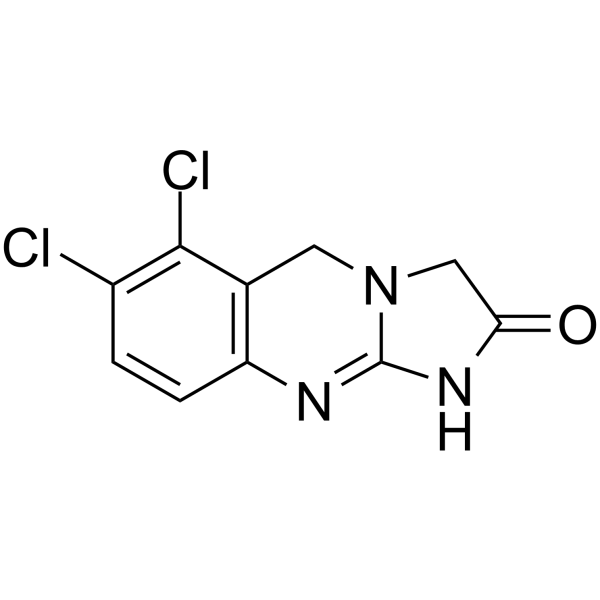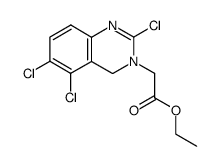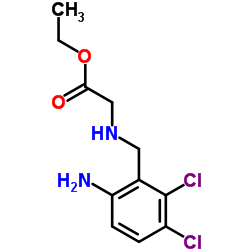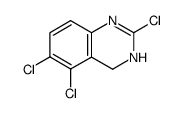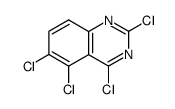58579-51-4
| Name | anagrelide hydrochloride |
|---|---|
| Synonyms |
6,7-Dichlor-1,5-dihydroimidazo[2,1-b]chinazolin-2(3H)-onhydrochlorid
imidazo[2,1-b]quinazolin-2(3H)-one, 6,7-dichloro-1,5-dihydro-, monohydrochloride 6,7-Dichloro-1,5-dihydroimidazo[2,1-b]quinazolin-2(3H)-one hydrochloride (1:1) 6,7-Dichloro-1,5-dihydroimidazo[2,1-b]quinazolin-2(3H)-one hydrochloride 6,7-dichloro-5,10-dihydro-3H-imidazo[2,1-b]quinazolin-2-one,hydrochloride MFCD01720337 Anagrelide Hydrochloride Imidazo[2,1-b]quinazolin-2(3H)-one, 6,7-dichloro-5,10-dihydro-, hydrochloride (1:1) 6,7-dichloro-1,5-dihydroimidazo[2,1-b]quinazolin-2(3H)-one chlorhydrate Anagrelide (hydrochloride) |
| Description | Anagrelide Hydrochloride(BL4162A) is a drug used for the treatment of essential thrombocytosis.Target: PDEAnagrelide hydrochloride is an oral imidazoquinazoline agent that has been shown to reduce elevated platelet counts and the risk of thrombosis in patients with thrombocythaemia in various myeloproliferative disorders (MPD). It is currently approved by the FDA as oral treatment for essential thrombocythaemia (ET) and thrombocythaemia associated with polycythaemia vera (PV). Anagrelide is known to inhibit platelet cyclic adenosine monophosphate (cAMP) phosphodiesterase at concentrations that exceed those achieved at doses used to treat ET. Anagrelide is extensively metabolised in the liver and its metabolites are primarily excreted in the urine [1]. Anagrelide is an established platelet-reducing drug. Studies have also investigated the effects of anagrelide on platelets, indicating that platelet function is as important as platelet counts in ET [2]. |
|---|---|
| Related Catalog | |
| References |
| Density | 1.77g/cm3 |
|---|---|
| Boiling Point | 376.5ºC at 760 mmHg |
| Melting Point | >280ºC |
| Molecular Formula | C10H8Cl3N3O |
| Molecular Weight | 292.549 |
| Flash Point | 181.5ºC |
| Exact Mass | 290.973297 |
| PSA | 44.70000 |
| LogP | 2.43060 |
| Storage condition | Desiccate at +4°C |
|
SECTION 1: Identification of the substance/mixture and of the company/undertaking Product identifiers Product name: Anagrelide hydrochloride REACH No.: A registration number is not available for this substance as the substance or its uses are exempted from registration, the annual tonnage does not require a registration or the registration is envisaged for a later registration deadline.
CAS-No.: 58579-51-4 Relevant identified uses of the substance or mixture and uses advised against Identified uses: Laboratory chemicals, Manufacture of substances SECTION 2: Hazards identification Classification of the substance or mixture Classification according to Regulation (EC) No 1272/2008 Acute toxicity, Oral (Category 4), H302 Skin irritation (Category 2), H315 Eye irritation (Category 2), H319 Specific target organ toxicity - single exposure (Category 3), Respiratory system, H335 For the full text of the H-Statements mentioned in this Section, see Section 16. Classification according to EU Directives 67/548/EEC or 1999/45/EC Xn HarmfulR22, R36/37/38 For the full text of the R-phrases mentioned in this Section, see Section 16. Label elements Labelling according Regulation (EC) No 1272/2008 Pictogram Signal wordWarning Hazard statement(s) H302Harmful if swallowed. H315Causes skin irritation. H319Causes serious eye irritation. H335May cause respiratory irritation. Precautionary statement(s) P261Avoid breathing dust. P305 + P351 + P338IF IN EYES: Rinse cautiously with water for several minutes. Remove contact lenses, if present and easy to do. Continue rinsing. Supplemental Hazardnone Statements Other hazards - none SECTION 3: Composition/information on ingredients Substances Synonyms: 6,7-Dichloro-1,5-dihydro-imidazo[2,1-b]quinazolin-2(3H)-one hydrochloride Formula: C10H7Cl2N3O . HCl Molecular Weight: 292,55 g/mol CAS-No.: 58579-51-4 Hazardous ingredients according to Regulation (EC) No 1272/2008 ComponentClassificationConcentration Anagrelide hydrochloride CAS-No.58579-51-4Acute Tox. 4; Skin Irrit. 2; Eye <= 100 % Irrit. 2; STOT SE 3; H302, H315, H319, H335 Hazardous ingredients according to Directive 1999/45/EC ComponentClassificationConcentration Anagrelide hydrochloride CAS-No.58579-51-4Xn, R22 - R36/37/38<= 100 % For the full text of the H-Statements and R-Phrases mentioned in this Section, see Section 16 SECTION 4: First aid measures Description of first aid measures General advice Consult a physician. Show this safety data sheet to the doctor in attendance. If inhaled If breathed in, move person into fresh air. If not breathing, give artificial respiration. Consult a physician. In case of skin contact Wash off with soap and plenty of water. Consult a physician. In case of eye contact Rinse thoroughly with plenty of water for at least 15 minutes and consult a physician. If swallowed Never give anything by mouth to an unconscious person. Rinse mouth with water. Consult a physician. Most important symptoms and effects, both acute and delayed The most important known symptoms and effects are described in the labelling (see section 2.2) and/or in section 11 Indication of any immediate medical attention and special treatment needed no data available SECTION 5: Firefighting measures Extinguishing media Suitable extinguishing media Use water spray, alcohol-resistant foam, dry chemical or carbon dioxide. Special hazards arising from the substance or mixture no data available Advice for firefighters Wear self contained breathing apparatus for fire fighting if necessary. Further information no data available SECTION 6: Accidental release measures Personal precautions, protective equipment and emergency procedures Use personal protective equipment. Avoid dust formation. Avoid breathing vapours, mist or gas. Ensure adequate ventilation. Evacuate personnel to safe areas. Avoid breathing dust. For personal protection see section 8. Environmental precautions Do not let product enter drains. Methods and materials for containment and cleaning up Pick up and arrange disposal without creating dust. Sweep up and shovel. Keep in suitable, closed containers for disposal. Reference to other sections For disposal see section 13. SECTION 7: Handling and storage Precautions for safe handling Avoid contact with skin and eyes. Avoid formation of dust and aerosols. Provide appropriate exhaust ventilation at places where dust is formed. For precautions see section 2.2. Conditions for safe storage, including any incompatibilities Store in cool place. Keep container tightly closed in a dry and well-ventilated place. Recommended storage temperature: 2 - 8 °C Store with desiccant. Specific end use(s) A part from the uses mentioned in section 1.2 no other specific uses are stipulated SECTION 8: Exposure controls/personal protection Control parameters Components with workplace control parameters Exposure controls Appropriate engineering controls Handle in accordance with good industrial hygiene and safety practice. Wash hands before breaks and at the end of workday. Personal protective equipment Eye/face protection Safety glasses with side-shields conforming to EN166 Use equipment for eye protection tested and approved under appropriate government standards such as NIOSH (US) or EN 166(EU). Skin protection Handle with gloves. Gloves must be inspected prior to use. Use proper glove removal technique (without touching glove's outer surface) to avoid skin contact with this product. Dispose of contaminated gloves after use in accordance with applicable laws and good laboratory practices. Wash and dry hands. The selected protective gloves have to satisfy the specifications of EU Directive 89/686/EEC and the standard EN 374 derived from it. Body Protection Complete suit protecting against chemicals, The type of protective equipment must be selected according to the concentration and amount of the dangerous substance at the specific workplace. Respiratory protection For nuisance exposures use type P95 (US) or type P1 (EU EN 143) particle respirator.For higher level protection use type OV/AG/P99 (US) or type ABEK-P2 (EU EN 143) respirator cartridges. Use respirators and components tested and approved under appropriate government standards such as NIOSH (US) or CEN (EU). Control of environmental exposure Do not let product enter drains. SECTION 9: Physical and chemical properties Information on basic physical and chemical properties a) AppearanceForm: solid b) Odourno data available c) Odour Thresholdno data available d) pHno data available e) Melting point/freezingno data available point f) Initial boiling point and no data available boiling range g) Flash pointno data available h) Evapouration rateno data available i) Flammability (solid, gas) no data available j) Upper/lowerno data available flammability or explosive limits k) Vapour pressureno data available l) Vapour densityno data available m) Relative densityno data available n) Water solubilityno data available o) Partition coefficient: n- no data available octanol/water p) Auto-ignitionno data available temperature q) Decompositionno data available temperature r) Viscosityno data available s) Explosive propertiesno data available t) Oxidizing propertiesno data available Other safety information no data available SECTION 10: Stability and reactivity Reactivity no data available Chemical stability Stable under recommended storage conditions. Possibility of hazardous reactions no data available Conditions to avoid no data available Incompatible materials Strong oxidizing agents Hazardous decomposition products Other decomposition products - no data available In the event of fire: see section 5 SECTION 11: Toxicological information Information on toxicological effects Acute toxicity no data available Skin corrosion/irritation no data available Serious eye damage/eye irritation no data available Respiratory or skin sensitisation no data available Germ cell mutagenicity no data available Carcinogenicity IARC:No component of this product present at levels greater than or equal to 0.1% is identified as probable, possible or confirmed human carcinogen by IARC. Reproductive toxicity no data available Specific target organ toxicity - single exposure no data available Specific target organ toxicity - repeated exposure no data available Aspiration hazard no data available Additional Information RTECS: Not available To the best of our knowledge, the chemical, physical, and toxicological properties have not been thoroughly investigated. SECTION 12: Ecological information Toxicity no data available Persistence and degradability no data available Bioaccumulative potential no data available Mobility in soil no data available Results of PBT and vPvB assessment PBT/vPvB assessment not available as chemical safety assessment not required/not conducted Other adverse effects no data available SECTION 13: Disposal considerations Waste treatment methods Product Offer surplus and non-recyclable solutions to a licensed disposal company. Dissolve or mix the material with a combustible solvent and burn in a chemical incinerator equipped with an afterburner and scrubber. Contaminated packaging Dispose of as unused product. SECTION 14: Transport information UN number ADR/RID: -IMDG: -IATA: - UN proper shipping name ADR/RID: Not dangerous goods IMDG: Not dangerous goods IATA:Not dangerous goods Transport hazard class(es) ADR/RID: -IMDG: -IATA: - Packaging group ADR/RID: -IMDG: -IATA: - Environmental hazards ADR/RID: noIMDG Marine pollutant: noIATA: no Special precautions for user no data available SECTION 15: Regulatory information This safety datasheet complies with the requirements of Regulation (EC) No. 1907/2006. Safety, health and environmental regulations/legislation specific for the substance or mixture no data available Chemical Safety Assessment For this product a chemical safety assessment was not carried out SECTION 16: Other information Full text of H-Statements referred to under sections 2 and 3. Acute Tox.Acute toxicity Eye Irrit.Eye irritation H302Harmful if swallowed. H315Causes skin irritation. H319Causes serious eye irritation. H335May cause respiratory irritation. Skin Irrit.Skin irritation Full text of R-phrases referred to under sections 2 and 3 XnHarmful R22Harmful if swallowed. R36/37/38Irritating to eyes, respiratory system and skin. Further information Copyright 2013 Co. LLC. License granted to make unlimited paper copies for internal use only. The above information is believed to be correct but does not purport to be all inclusive and shall be used only as a guide. The information in this document is based on the present state of our knowledge and is applicable to the product with regard to appropriate safety precautions. It does not represent any guarantee of the properties of the product. Corporation and its Affiliates shall not be held liable for any damage resulting from handling or from contact with the above product. See and/or the reverse side of invoice or packing slip for additional terms and conditions of sale. |
CHEMICAL IDENTIFICATION
HEALTH HAZARD DATAACUTE TOXICITY DATA
|
| Symbol |

GHS07 |
|---|---|
| Signal Word | Warning |
| Hazard Statements | H302-H315-H319-H335 |
| Precautionary Statements | P261-P305 + P351 + P338 |
| Hazard Codes | Xn |
| Risk Phrases | 22-36/37/38 |
| Safety Phrases | 26 |
| RIDADR | NONH for all modes of transport |
| HS Code | 2933990090 |
|
~67% 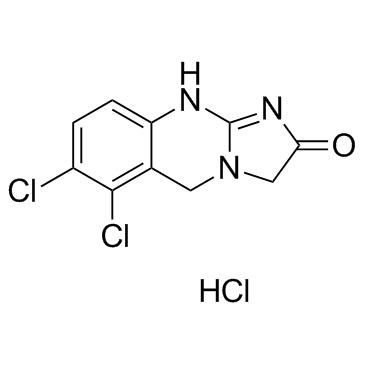
58579-51-4 |
| Literature: AOP ORPHAN PHARMACEUTICALS AG Patent: WO2005/80398 A1, 2005 ; Location in patent: Page/Page column 6 ; |
|
~76% 
58579-51-4 |
| Literature: Yamaguchi, Hitoshi; Ishikawa, Fumiyoshi Journal of Heterocyclic Chemistry, 1981 , vol. 18, p. 67 - 70 |
|
~% 
58579-51-4 |
| Literature: US4146718 A1, ; |
|
~% 
58579-51-4 |
| Literature: Journal of Heterocyclic Chemistry, , vol. 18, p. 67 - 70 |
|
~% 
58579-51-4 |
| Literature: Journal of Heterocyclic Chemistry, , vol. 18, p. 67 - 70 |
| Precursor 4 | |
|---|---|
| DownStream 0 | |
| HS Code | 2933990090 |
|---|---|
| Summary | 2933990090. heterocyclic compounds with nitrogen hetero-atom(s) only. VAT:17.0%. Tax rebate rate:13.0%. . MFN tariff:6.5%. General tariff:20.0% |

